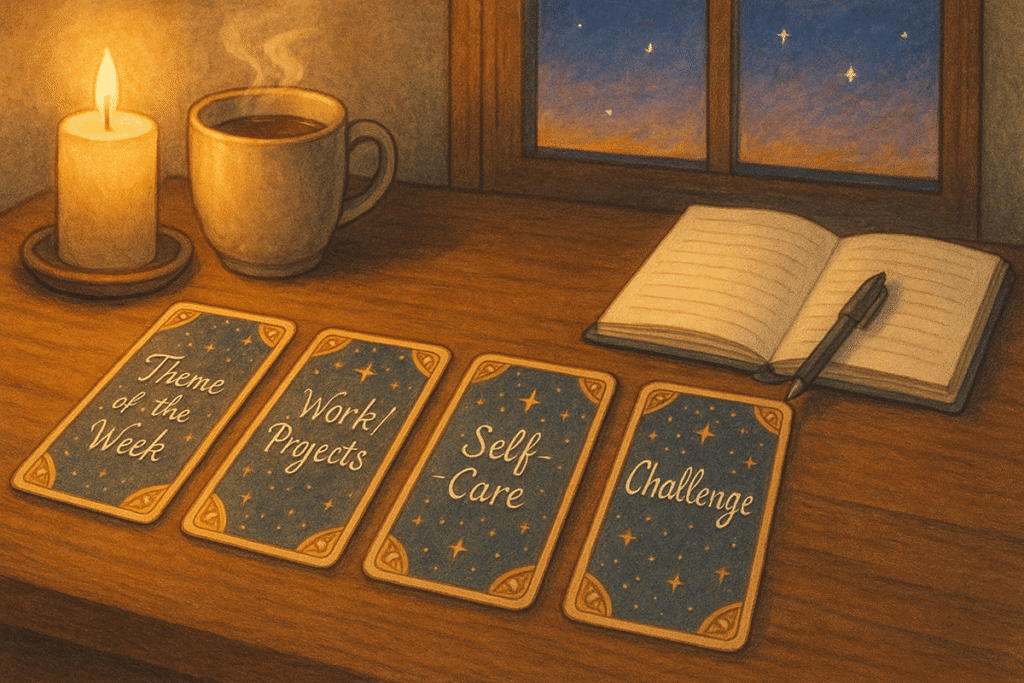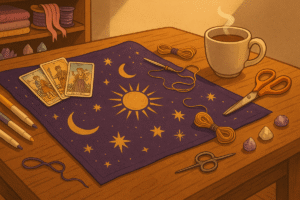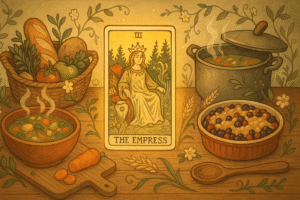Table of Contents
Sunday evenings have always felt like a threshold to me. There’s something about the quiet settling in, the way the weekend’s energy starts to fade, and Monday morning begins to whisper from around the corner. I’ve found that this natural pause makes it the perfect time for planning week with tarot.
Over the years, I’ve experimented with different ways to prepare for the week ahead. I’ve tried elaborate planners, digital apps, and detailed scheduling systems. But nothing has felt quite as grounding and insightful as pulling out my tarot deck on a Sunday evening and having a gentle conversation with the cards about what’s coming.
The beauty of using tarot for weekly planning isn’t about predicting what will happen. Instead, it’s about creating a space for reflection and intention setting. When I lay out cards for the week ahead, I’m not asking them to tell me my future. I’m asking them to help me think through what I want to focus on, what I might need to pay attention to, and how I can approach the coming days with more awareness.
Why Sunday Evening Works Best for Weekly Tarot Planning
There’s something almost magical about Sunday evenings that makes them ideal for this kind of reflective practice. The weekend has given us time to step back from our usual routines, and we’re naturally beginning to think about what’s ahead. Our minds are often clearer, less cluttered with the immediate demands of work and daily responsibilities.
I’ve noticed that when I do this practice on Sunday evening, I sleep better that night. Perhaps it’s because I’ve taken time to mentally organize the week ahead, or maybe it’s the calming ritual of shuffling cards and sitting quietly with my thoughts. Either way, I wake up Monday morning feeling more centered and purposeful.
The timing also allows for practical follow through. Once I’ve done my weekly spread, I can incorporate any insights into my actual planning. If a card suggests I need to focus more on self care, I can look at my calendar and see where I might build in some extra rest time. If the cards point toward potential challenges in communication, I can be more mindful of how I phrase emails or approach difficult conversations.
The Simple Sunday Spread Structure
After trying various complex spreads over the months, I’ve settled on a beautifully simple four card layout that covers everything I need without feeling overwhelming. I call it the Sunday Planning Spread, and it’s become as much a part of my weekend routine as making Sunday dinner or preparing clothes for Monday.
The spread uses just four cards, each with a specific focus. I lay them out in a straight line from left to right, taking time with each one to really consider what it might be inviting me to explore. The positions are Theme of the Week, Work and Projects Focus, Self Care Focus, and Potential Challenge to Navigate.
What I love about this structure is that it covers the major areas of my life without getting too complicated. It acknowledges that I have professional responsibilities and personal needs, and it gently reminds me that challenges are a normal part of life rather than something to fear. The spread feels balanced and realistic.
Position One: Theme of the Week
The first card I draw represents the overall theme or energy for the week ahead. This isn’t about what will happen, but rather about what kind of approach or mindset might serve me well. Sometimes this card suggests qualities I might want to cultivate, and other times it points to areas where I might need to pay extra attention.
When I pull a card like The Hermit for this position, I interpret it as an invitation to look inward this week. Maybe it’s time for some quiet reflection, or perhaps I need to trust my own wisdom rather than constantly seeking input from others. The Three of Cups might suggest that connection and community will be important themes, encouraging me to reach out to friends or collaborate more actively on projects.
I’ve learned not to worry too much if I don’t immediately understand what a card means for the week ahead. Sometimes the theme becomes clear by Wednesday or Thursday, when I realize I’ve been naturally gravitating toward the qualities the card represented. Other times, I find that consciously trying to embody the card’s energy actually shapes how my week unfolds.
The theme card serves as a gentle guide rather than a rigid rule. It’s like having a word of the week that I can return to when I need to refocus or when I’m making decisions about how to spend my time and energy.
Position Two: Work and Projects Focus
The second card addresses where to direct my professional energy and attention during the coming week. This might highlight a particular project that deserves extra focus, suggest an approach to take with challenging tasks, or point toward skills I should lean into.
I remember one week when I drew the Four of Pentacles in this position. Initially, I felt a bit concerned because this card often speaks to holding too tightly to resources or being overly cautious. But as the week unfolded, I realized it was excellent advice. I had been spreading myself too thin across multiple projects, and the card was encouraging me to focus more deeply on fewer things.
Sometimes this position brings up cards that challenge my usual way of working. The Page of Wands might suggest approaching tasks with more curiosity and experimentation, while the Queen of Swords could be inviting me to communicate more directly and clearly in professional settings.
What I find particularly helpful about this card is that it often highlights aspects of my work life that I haven’t been considering. It might draw my attention to the importance of collaboration when I’ve been too focused on solo work, or remind me to slow down and be more thorough when I’ve been rushing through tasks.
Position Three: Self Care Focus
The third card has become perhaps the most valuable part of this entire spread. It addresses what kind of self care and personal attention I might need during the week ahead. This isn’t about prescriptive wellness advice, but rather about tuning into what would genuinely nurture me right now.
Some weeks, this card points toward physical care. The Ace of Pentacles might suggest paying attention to nutrition or getting outside more often. Other weeks, it highlights emotional or mental needs. The Two of Cups could be encouraging me to prioritize quality time with loved ones, while the Hermit might be suggesting that I need more solitude and quiet reflection.
I’ve been surprised by how often this card reveals needs I hadn’t consciously recognized. There have been weeks when I thought I just needed to push through and be more productive, but the self care card suggested something completely different. Maybe it was time to rest, to play, to create something just for fun, or to have difficult conversations I’d been avoiding.
What I appreciate about approaching self care through tarot is that it moves away from generic wellness advice toward something more personalized and intuitive. Instead of assuming I need the same thing every week, I’m invited to check in with what would actually be helpful right now.
Position Four: Potential Challenge to Navigate
The final card looks at what kind of challenge or obstacle I might encounter during the week, not so I can worry about it, but so I can be more prepared and intentional in how I respond. This card has taught me that challenges aren’t necessarily negative things to be avoided, but often opportunities for growth and learning.
Sometimes this position reveals internal challenges. The Seven of Swords might suggest a tendency to take shortcuts or avoid direct communication, while the Five of Cups could point toward getting stuck in disappointment rather than moving forward. Other times, it highlights external situations that might require extra patience or creativity.
I’ve found that knowing about potential challenges ahead of time actually makes them easier to handle. If the card suggests I might struggle with focus this week, I can plan for shorter work sessions and more breaks. If it points toward possible miscommunications, I can be more careful about how I express myself and more generous in how I interpret others.
The challenge card reminds me that difficulties are a normal part of life, and that I have more power than I sometimes realize to choose how I respond to them. It’s like having a weather forecast that helps me decide what to wear and what activities to plan.
Making the Most of Your Weekly Reading
Once I’ve laid out all four cards and spent time reflecting on each one, I like to take a few minutes to think about how they connect to each other. Sometimes the theme card and the self care card work together beautifully, creating a coherent message about what I need for the week. Other times, there might be interesting tensions between the work focus and the potential challenge that help me think more deeply about balance and priorities.
I keep a simple journal where I write down the cards I drew and my initial thoughts about each one. Then, throughout the week, I occasionally check back to see how things are unfolding. By Friday evening, I often have a clearer sense of what the cards were pointing toward, and I’ve usually found several moments when remembering the reading helped me make better choices.
The key is to hold the reading lightly. These cards are companions for reflection, not commands to follow rigidly. Some weeks I find deep wisdom in every position, and other weeks only one or two cards feel particularly relevant. Both experiences are perfectly fine.
This practice has become less about getting answers from the cards and more about creating regular time for intentional thinking about my life. The cards simply provide a framework for considering different aspects of my week and approaching the coming days with more awareness and purpose.
Planning week with tarot has transformed my Sunday evenings from a time of vague anxiety about Monday morning into a peaceful ritual of preparation and intention setting. It’s a practice that honors both the practical need to organize our lives and the deeper desire to live with more mindfulness and purpose.
Frequently Asked Questions
What if I don’t understand what a card means for my week?
It’s completely normal to feel confused when interpreting cards, even with experience. If a card doesn’t make sense right away, write it down in a journal and revisit it mid-week or at the end of the week. Often the meaning becomes clear as events unfold, and you’ll start to recognize patterns between the cards and your actual experiences. Trust that understanding develops with time and practice.
Do I need to do this spread every Sunday, or can I choose a different day?
The key is to perform this spread on the evening of your last rest day before your working week begins. If your work week starts on a different day than Monday, adjust accordingly. The important part is creating consistency in your routine, whether that’s Sunday evening, Tuesday night, or any other day that marks the transition into your active week.
Should I keep a journal of my weekly readings?
Writing down your weekly spreads is highly recommended because it helps you understand the cards better as the week unfolds and sharpens your reading skills over time. Recording the cards you drew and your initial thoughts allows you to reflect back and see how accurate your interpretations were, which builds both your confidence and your intuitive connection with the deck.
What if I pull a challenging or “negative” card?
Remember that challenging cards aren’t warnings of doom but invitations for awareness and preparation. If you draw a difficult card in any position, treat it as helpful information about where you might need extra patience, attention, or self-care during the week. These cards give you the opportunity to approach potential obstacles with intention rather than being caught off guard.







